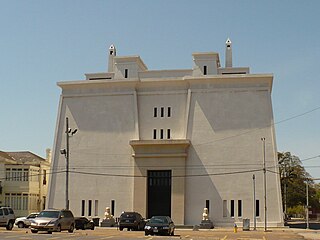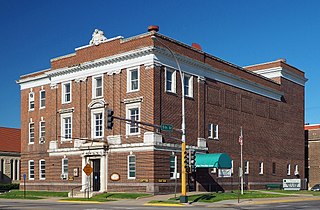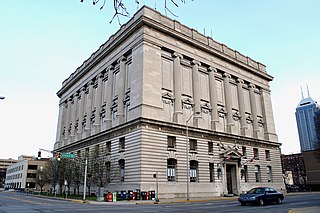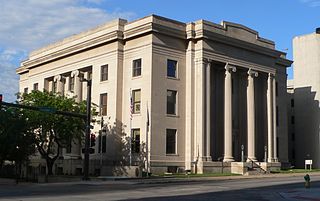
The Oklahoma State Capitol is the house of government of the U.S. state of Oklahoma. It is the building that houses the Oklahoma Legislature and executive branch offices. It is located along Lincoln Boulevard in Oklahoma City and contains 452,508 square feet of floor area. The present structure includes a dome completed in 2002.

The Nevada State Capitol is the capitol building of the U.S. state of Nevada located in the state capital of Carson City at 101 North Carson Street. The building was constructed in the Neoclassical Italianate style between 1869 and 1871. It is listed in the National Register of Historic Places. It is also Nevada Historical Marker number 25.

The House of the Temple is a Masonic temple in Washington, D.C., United States that serves as the headquarters of the Scottish Rite of Freemasonry, Southern Jurisdiction, U.S.A.

The Detroit Masonic Temple is the world's largest Masonic Temple. Located in the Cass Corridor of Detroit, Michigan, at 500 Temple Street, the building serves as a home to various masonic organizations including the York Rite Sovereign College of North America. The building contains a variety of public spaces including three theaters, three ballrooms and banquet halls, and a 160 by 100 feet clear-span drill hall.

The Salt Lake Masonic Temple is the Masonic headquarters for Utah, and is Salt Lake City's best example of Egyptian Revival architecture. It was completed in 1927, and is located in the South Temple Historic District of Salt Lake City, Utah, United States.
Scottish Rite Cathedral and Scottish Rite Temple are names commonly applied to buildings used by Ancient and Accepted Scottish Rite, a body associated with Freemasonry. It may refer to any of a number of specific buildings, including:

Scottish Rite Temple, also known as The Temple Downtown, is a historic former masonic building in Mobile, Alabama, United States. It was built to serve as the meeting place for the Ancient and Accepted Scottish Rite of Freemasonry. The building was designed by George Bigelow Rogers, a local Mobile architect who was responsible for designing many of the city's buildings during this period. The cornerstone was laid on November 30, 1921, with the building completed in 1922. It is the only intact example of the Egyptian Revival style in Mobile. It was placed on the National Register of Historic Places on January 5, 1984. It was sold in 1996 to a private citizen and reopened as a banqueting venue.

Frederick Heath was an American architect responsible for numerous projects in Tacoma, Washington. He worked out of his own office and as a senior partner at architectural firms. He was involved with Spaulding, Russell & Heath, and Heath & Gove. His work included designs for several historic and notable schools, churches, stadiums, and commercial properties.

The Winona Masonic Temple is a historic Masonic Temple in Winona, Minnesota, United States, completed in 1909. Many local civic and business leaders were members of the lodge. Containing a large ballroom and other meeting space, the building was an important venue in Winona for both Masonic activities and general public events. The Winona Masonic Temple was listed on the National Register of Historic Places in 1998 for having state-level significance in the themes of art and social history. It was nominated as the headquarters of a fraternal organization important to Winona's civic and social development, and for containing Minnesota's largest collection of Masonic theatre backdrops and stage equipment.

The Coeur d'Alene Masonic Temple in Coeur d'Alene, Idaho is a building constructed during 1909–1911. It was listed on the National Register of Historic Places in 1978.

The Kilbourn Masonic Temple is a historic Masonic building located in Milwaukee, Wisconsin. It was constructed in 1911 as a meeting hall for Kilbourn Lodge #3, a local Masonic lodge which was one of the first three organized in Wisconsin in 1843. The Masons no longer meet in the building). It was listed on the National Register of Historic Places in 1986. When it celebrated its 100th anniversary in 2011, the temple was automatically deemed a landmark in the city of Milwaukee. The temple now serves as a fraternity house for the Kappa Sigma chapter at Marquette University.

The current Indianapolis Masonic Temple, also known as Indiana Freemasons Hall, is a historic Masonic Temple located at Indianapolis, Indiana. Construction was begun in 1908, and the building was dedicated in May 1909. It is an eight-story, Classical Revival style cubic form building faced in Indiana limestone. The building features rows of engaged Ionic order columns. It was jointly financed by the Indianapolis Masonic Temple Association and the Grand Lodge of Free and Accepted Masons of Indiana, and was designed by the distinguished Indianapolis architectural firm of Rubush and Hunter.

The Mosque of the El Jebel Shrine, which has also been known as the Rocky Mountain Consistory, and as the Scottish Rite Temple is a historic building in the North Capitol Hill neighborhood of downtown Denver. It was for a period known as Sherman Street Event Center

The McAlester Scottish Rite Temple, also known as Masonic Temple or the McAlestor Consistory, is a building in McAlester, Oklahoma that was built in 1907 and 1928–1930. It was listed on the National Register of Historic Places in 1980.

The Scottish Rite Cathedral is a Masonic building in Omaha in the state of Nebraska in the Midwestern United States. Begun in 1912 and opened in 1914, it remains in use by the Scottish Rite.
The Guthrie Scottish Rite Museum is a museum in Guthrie, Oklahoma.

The Cedar Rapids Scottish Rite Temple, also known as the Scottish Rite Masonic Center, is a historic building located at 616 A Avenue, Cedar Rapids, Iowa. It is listed on the National Register of Historic Places (NRHP) as Consistory Building No. 2

The Asheville Masonic Temple is a Masonic Temple located in Asheville, North Carolina. Designed by British American architect and Freemason Richard Sharp Smith, the building was opened in April 1915. It is listed in the United States National Register of Historic Places as a contributing building in the Downtown Asheville Historic District.

The Albert Pike Memorial Temple is a historic Masonic lodge at 700-724 Scott Street in Little Rock, Arkansas. It is an imposing three-story Classical Revival structure, finished in limestone, and featuring a long colonnade of 40-foot (12 m) Ionic columns on its front facade, which occupies half of a city block. Entry is gained to the building via three sets of massive bronze doors flanked by stone eagles. Completed in 1924, it was designed by local Masons George R. Mann and Eugene Stern. It is named in honor of Albert Pike.

The Bay City Masonic Temple is a historic building located at 700 North Madison Avenue in Bay City, Michigan. It was listed on the National Register of Historic Places in 1982.




















